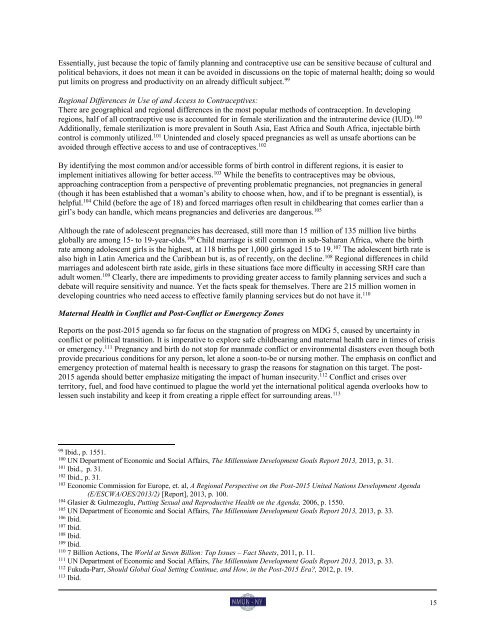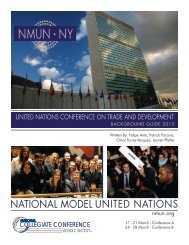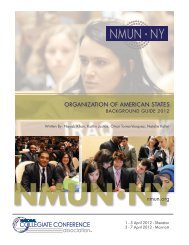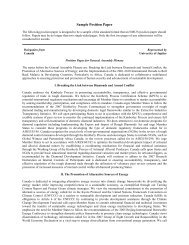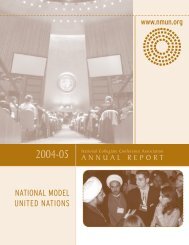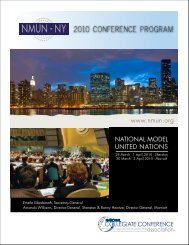UNFPA Background Guide - National Model United Nations
UNFPA Background Guide - National Model United Nations
UNFPA Background Guide - National Model United Nations
Create successful ePaper yourself
Turn your PDF publications into a flip-book with our unique Google optimized e-Paper software.
Essentially, just because the topic of family planning and contraceptive use can be sensitive because of cultural and<br />
political behaviors, it does not mean it can be avoided in discussions on the topic of maternal health; doing so would<br />
put limits on progress and productivity on an already difficult subject. 99<br />
Regional Differences in Use of and Access to Contraceptives:<br />
There are geographical and regional differences in the most popular methods of contraception. In developing<br />
regions, half of all contraceptive use is accounted for in female sterilization and the intrauterine device (IUD). 100<br />
Additionally, female sterilization is more prevalent in South Asia, East Africa and South Africa, injectable birth<br />
control is commonly utilized. 101 Unintended and closely spaced pregnancies as well as unsafe abortions can be<br />
avoided through effective access to and use of contraceptives. 102<br />
By identifying the most common and/or accessible forms of birth control in different regions, it is easier to<br />
implement initiatives allowing for better access. 103 While the benefits to contraceptives may be obvious,<br />
approaching contraception from a perspective of preventing problematic pregnancies, not pregnancies in general<br />
(though it has been established that a woman’s ability to choose when, how, and if to be pregnant is essential), is<br />
helpful. 104 Child (before the age of 18) and forced marriages often result in childbearing that comes earlier than a<br />
girl’s body can handle, which means pregnancies and deliveries are dangerous. 105<br />
Although the rate of adolescent pregnancies has decreased, still more than 15 million of 135 million live births<br />
globally are among 15- to 19-year-olds. 106 Child marriage is still common in sub-Saharan Africa, where the birth<br />
rate among adolescent girls is the highest, at 118 births per 1,000 girls aged 15 to 19. 107 The adolescent birth rate is<br />
also high in Latin America and the Caribbean but is, as of recently, on the decline. 108 Regional differences in child<br />
marriages and adolescent birth rate aside, girls in these situations face more difficulty in accessing SRH care than<br />
adult women. 109 Clearly, there are impediments to providing greater access to family planning services and such a<br />
debate will require sensitivity and nuance. Yet the facts speak for themselves. There are 215 million women in<br />
developing countries who need access to effective family planning services but do not have it. 110<br />
Maternal Health in Conflict and Post-Conflict or Emergency Zones<br />
Reports on the post-2015 agenda so far focus on the stagnation of progress on MDG 5, caused by uncertainty in<br />
conflict or political transition. It is imperative to explore safe childbearing and maternal health care in times of crisis<br />
or emergency. 111 Pregnancy and birth do not stop for manmade conflict or environmental disasters even though both<br />
provide precarious conditions for any person, let alone a soon-to-be or nursing mother. The emphasis on conflict and<br />
emergency protection of maternal health is necessary to grasp the reasons for stagnation on this target. The post-<br />
2015 agenda should better emphasize mitigating the impact of human insecurity. 112 Conflict and crises over<br />
territory, fuel, and food have continued to plague the world yet the international political agenda overlooks how to<br />
lessen such instability and keep it from creating a ripple effect for surrounding areas. 113<br />
99<br />
Ibid., p. 1551.<br />
100<br />
UN Department of Economic and Social Affairs, The Millennium Development Goals Report 2013, 2013, p. 31.<br />
101<br />
Ibid., p. 31.<br />
102<br />
Ibid., p. 31.<br />
103<br />
Economic Commission for Europe, et. al, A Regional Perspective on the Post-2015 <strong>United</strong> <strong>Nations</strong> Development Agenda<br />
(E/ESCWA/OES/2013/2) [Report], 2013, p. 100.<br />
104<br />
Glasier & Gulmezoglu, Putting Sexual and Reproductive Health on the Agenda, 2006, p. 1550.<br />
105<br />
UN Department of Economic and Social Affairs, The Millennium Development Goals Report 2013, 2013, p. 33.<br />
106<br />
Ibid.<br />
107<br />
Ibid.<br />
108<br />
Ibid.<br />
109<br />
Ibid.<br />
110<br />
7 Billion Actions, The World at Seven Billion: Top Issues – Fact Sheets, 2011, p. 11.<br />
111<br />
UN Department of Economic and Social Affairs, The Millennium Development Goals Report 2013, 2013, p. 33.<br />
112<br />
Fukuda-Parr, Should Global Goal Setting Continue, and How, in the Post-2015 Era?, 2012, p. 19.<br />
113<br />
Ibid.<br />
15


